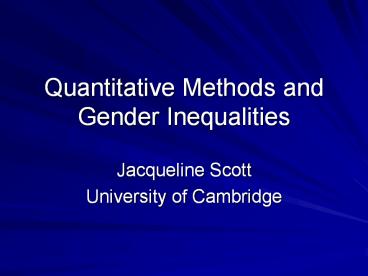Quantitative Methods and Gender Inequalities PowerPoint PPT Presentation
1 / 22
Title: Quantitative Methods and Gender Inequalities
1
Quantitative Methods and Gender Inequalities
- Jacqueline Scott
- University of Cambridge
2
Outline
- Consider whether early feminist opposition to
quantitative research makes sense - Introduce the ESRC Research Priority Network on
Gender Inequalities (GeNet) as an exemplar - Discuss the diverse methodologies of GeNet
against a fit for purpose evaluative framework - Consider challenges posed by understanding
intersectionalities in gender research - Identify how qualitative methods used to inform
and sharpen the ways quantitative researchers
count
3
Feminism in 1970s /1980s
- Emphasis on making women visible in social
sciences and giving voice - Concern about objectivity impersonal
knowledge being all too biased - Challenge to essentialist arguments about
natural differences between men and women - Championing of qualitative over quantitative
4
(No Transcript)
5
(No Transcript)
6
The difference gender makes
- Shift from women to gender
- Gender as analytical category gendered
processes..inclusive of male and females.. - Inequalities both between men and woman and also
within men and women - Intersectionalities gender, race, class, age..
More nuanced understanding
7
ESRC Gender Equality Network
- Research Priority Network on Gender Inequalities
in Production Reproduction - www.genet.ac.uk
8
Background
- Demise of male breadwinner family - labour market
changes/changes in parenting partnership - Paradigm shift in gender relations
- Greater policy recognition of equality although
policies ambiguous - Some human capital convergence but inequalities
persistent
9
9 Linked Projects3 Inter-related themes
- Pathways to Adult Attainment Life Course
Processes - Changing occupations and careers of women and men
- Biographical agency and developmental outcomes
- Gendered pathways from childhood disadvantage to
adulthood - Gender, time allocation in paid and unpaid work
the wage gap - Resources, Gender, Ethnic Class Inequalities
- Within-household inequalities in income and power
- Gender, ethnicity, migration and service
employment - Class gender, employment and family
- Policy Responses to Gender Inequalities
- Addressing gender inequality through corporate
governance - Policy initiatives tackling inequalities in work
and care in UK EU
10
3 different methodologies
- Pathways to Adult Attainment Life Course
Processes - QUANTITATIVE LONGITUDINAL ANALYSIS - unpacking
gendered processes and changes across time - Longitudinal analysis of cohort differences in
occupations and careers (Shirley Dex and Heather
Joshi) - Childhood and adolescent transitions to adulthood
across cohorts (Ingrid Schoon) - Gendered pathways from childhood disadvantage to
adulthood across cohorts (Wendy Sigle-Ruston and
John Hobcraft) - Gender, time allocation in paid and unpaid work
the wage gap using the BHPS (Gershuny) - Resources, Gender, Ethnic Class Inequalities
- MIXED METHODS (qualitative unpacking the
specific context quantitative providing
estimates of sub-group differences within the
population) - Within-household inequalities in income and power
(Himmelweit, Sutherland and Bennett) - Gender, ethnicity, migration and service
employment (McDowell) - Class gender, employment and family (Crompton)
- Policy Responses to Gender Inequalities
- QUALITATIVE semi-structured interviewing
documentary analysis - Addressing gender inequality through corporate
governance (Deakin)
11
Inter-twining of theory, empirical research and
methodology
- GeNet has explicit goal of promoting highest
possible methodological standards in its own
gender research and contributing to ESRCs
various methodological and training initiatives
that are concerned to raise standards of social
science generally - Is there a feminist method? No what matters
for feminist research is fit for purpose and
feminist research is sufficiently broad-ranging
that it spans quantitative and qualitative
divides
12
Questions requiring quantitative analysis
(Source Joshi and Pacci 1998)
- Pay gap narrowing for those aged 26 (enhanced
human capital and labour market experience
Equal Pay Act 1970 75)
13
Masculinization of Female Life Course (UK Cohort
effects Participation- Joshi et al 2005)
14
(No Transcript)
15
The combined effects of various factors on the
gender difference in annual earnings of 1995
graduates seven years after graduation
16
Time-use investigation (Gershuny et al)
- Hypothesis substantial part of gender gap in
wages that persists beyond operation of
work-place equal opportunities can be explained
in terms of day-to-day practices of unequal
division of production and caring activities in
household. - Data British Household Panel and Harmonised
European Time Use
17
Time use by family change Women aged 20- 40
(Gershuny 2004)
18
Time use by family changeMen aged 20-40
(Gershuny 2004)
19
(No Transcript)
20
Lagged adaptation
- Over the long term women who carry dual burden
have choices suffer, argue, quit - Not much of real choice so what happens?
- Over time, women and mens share of domestic
division of labour becomes more equal, with women
reducing unpaid work immediately, but mens take
up of home chores taking longer and being less
reliable
21
time on work (mins of day)
neths UK USA Sweden W Germ
Core domestic work Core domestic work Core domestic work Core domestic work Core domestic work Core domestic work
Male 29 28 33 56 11
Female 188 177 182 143 238
Other unpaid work Other unpaid work Other unpaid work Other unpaid work Other unpaid work Other unpaid work
Male 84 83 97 117 84
Female 124 111 142 146 132
Paid work Paid work Paid work Paid work Paid work Paid work
Male 325 367 406 379 418
Female 94 178 187 262 168
Total work Total work Total work Total work Total work Total work
Male 438 478 536 552 513
Female 406 466 511 551 538
22
Range of models of work-family balance
Model Description Policies Countries
Adult worker model Supported Unsupported Lone parents low earners Gender neutral Childcare Work benefits Tax credits Model encouraged in EU UK since 1999 USA
Nordic gender Differentiated adult worker Equality allowing for difference Cash support for parental leave care relief parental leave provision Sweden to lesser extent other Scandinavian
Gender equality based on female model Male and female reduced hours Netherlands

